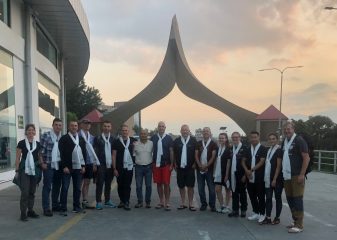159RLC EX DRAGON BARBARIAN NEPAL 7th October to 30th October 2023
Planning a trip such as adventure training in Nepal can take literally years to get everything right and ensure all the important considerations are met. On top of this, finances are possibly the biggest restriction now on any large organisation and especially those in the public eye, where being able to demonstrate that funds are being used both wisely and cost effectively is of paramount importance. Just when you think everything is organised, activities would seem to cost more than they did a few months ago which can make planning any trip very difficult when the budget would appear to be so fluid.
This is exactly what happened with Barbarian Nepal; activities, flights, transport and accommodation to name just a few variables, were all costed out and then, after approval was given, the actual cost bore no resemblance to what was planned. At this point the Barbarian Nepal team was incredibly fortunate to receive a considerable contribution from the Ulysses Trust who were able to help put our trip back on track.
The Ulysses Trust website states
We change lives through enabling outdoor challenge, exploration and adventure – supporting activities that deliver confidence, resilience, self-awareness and values – opening eyes to a world of unseen opportunity, and achievement beyond expectation.
It is no exaggeration to highlight that the Ulysses Trust has changed the lives of 14 British Army Reservists as quite simply without their financial support, the trip of a lifetime would have been cut short or been reduced in training value.
159 RLC are extremely grateful for the support they received, and this article highlights some of the incredible things we experienced over our trip to Nepal in October 2023
Only 2 out of the 14 members of the team had ever visited Nepal previously and for the most part the rest the expedition was made up of British Army Reservists with limited experience who had certainly not tasted the thin air and altitude of some of the mountains of Nepal. The Himalayas holds an unbelievable 3411 peaks, with over 130 reaching the dizzy heights of 7000m plus. From the moment we all accepted the invitation to attend this expedition, everyone knew this was not going to be like trekking around the Lake District, creeping up to nearly 1000m, this was going to be different.
Saturday 7th October saw the team all meet up at 159 Regt HQ. It’s fair to say there was a huge buzz in the air as everyone was excited, although may be a little nervous. A few members of the team were not from our Regiment, so introductions were in order, and we gathered around in a circle to explain what we were hoping to both bring to the expedition and but also what we hoped to gain. The theme was very much along the lines of expanding our mountain knowledge and experience, pushing boundaries but more importantly ensuring the success of the team. It was important that we all put the team first and ourselves second.
A quick drive to Heathrow and we were on our way. The first flight to Doha passed quickly and the chosen airline was reasonably comfortable. Most people managed a quick nap even though we had a few stiff necks the next day. Just a two hour stop over at Doha, and we were on our way again on the next flight to Kathmandu. A little travel fatigue was kicking in now and we were all ready for some sleep, so it was fantastic to be booked into a nice hotel for the first night. Everyone knew this was a treat and the tea houses to come would not be offering the same level of luxury, but it was great to get a good night’s sleep after an informative brief from the trekking company’s director and the two guides who we would come to rely on so much. The message was clear from the guides, eat plenty, drink plenty of fluids and savour every moment of the trip, something we all felt we could engage with instantly, but of course it would prove to be much harder than we thought.
A long jeep ride on the second day saw us arrive a little shaken from possibly the bumpiest roads we have ever experienced in a very surprising 28 degree heat. This was not what many of were expecting. If this was the Himalayas, where was the snow? It is easy to forget that, at lower altitudes, Nepal is lush green and very warm. Most of the country doesn’t drop below about 6 degrees even in the middle of winter.
The first tea house was called Hotel Everest in Machhakhola, 869m, which made us all smile and we wondered how many Hotel Everests there are in Nepal? It was clean, simple and the food they provided was freshly cooked and hot which was all that mattered. More importantly this marked the point where we had really arrived. No more planes, jeeps or minibuses, we’d be walking from now and after the 2- 3 days of travelling, we were ready to start the best part of our journey. We had all moved our kit into the bags provided and adhered to the 15kg limit. The porters quickly tied two bags together and were to set off each morning just before us. Throughout the whole trip, it was remarkable how effortlessly they moved over tricky steep terrain, carrying 30kg; these are fit strong people very used to the tough mountain life, but they never stop smiling.
Our Expedition Leader quickly wanted us to get into the mountain routine, so reveille was set at 05:30, breakfast at 06:00 and out the door for 07:00. This was maintained throughout the trek and on the hottest days it was brilliant, as at least half the trek each day was completed without the full strength of the sun beating down on us. However, when it was minus 10 degrees, we all looked forward to the arrival of the warmth of the sun and the start of the new day which was slow to arrive when were had such incredible high peaks surrounding you.
We walked steadily for the first few days and the distances we covered were around 20km each day. The scenery became even more spectacular as we turned every corner and navigating waterfalls gave everyone a good soaking, but it was warm, so we were all dry within a few minutes.
The bridges posed the first challenge for most of us myself included. You know they are safe in your mind, but your body tells you something entirely different. They sway as soon as more than one person is on them and they are high, like really high,
sometimes a few hundred meters up over raging glacial rivers. This was very much into the stretching the comfort zone area for probably half the group. Interestingly though everyone became very comfortable on them after a few days, I guess that the growth part of what we were doing is an important reminder that AT can change your perception of things and allow you to go just that little bit further. It was not about risk it’s about your ability to overcome a perceived risk.
After three days trekking, we had reached Namrung (2630 – twice the height of Ben Nevis) and it was noticeable that the terrain was changing as well as the tea houses we were staying at. Pretty much everything is transported by donkeys so the more remote and the higher you travel, the more the Nepalese people must rely on animals to transport what was needed.
The menu at the tea house was much more basic now and the choices more limited but the standard was still just as good. Namrung was really pretty and had what many felt was the nicest accommodation, the small wooden structures were picture postcard pretty and very clean and spacious. A hot shower l was very welcome after a couple of days of freezing washes from a tap. I think everyone enjoyed this night’s sleep especially knowing that tomorrow would take us into the 3000m plus range, which felt like a huge milestone, and the start of the next leg of the journey.
The Mountain Leaders of the group were now having to assess some of the routes more carefully. Landslides, steep inclines/declines, narrow paths, and some of the most precarious bridges meant single file and much more focus on safety was necessary. It felt safe though and we all provided encouragement to each other when certain aspects seemed more precarious, and we only crossed an obstacle when we had all agreed the appropriate plan. The distances we were travelling had halved after 4 days trekking as well as we approached Lho at 3180m the thinner air was having an effect. A few individuals were starting to experience minor headaches and consuming as much food as possible along with 4 litres of water was really tough. Appetites were flat and not everyone was sleeping as well as we were originally. This was where ego had to be left behind, sure we could have walked much further and covered a lot more ground, but altitude adjustment is a process not to be rushed and the longer you take the better your body will adjust to the reduction in oxygen in the air. Another important lesson for us all was that we had a plan, and we were sticking to it rather than trying to achieve more and putting ourselves at unnecessary risk.
Trekking day 5 was a pivotal point as we arrived in Sama at 3520m, the lush greenery had become more sparse and there was a chill in the air. This was to be our acclimatisation break for the next 36hrs and a welcome relief for those who had a few aches, pains, and blisters. Overall, the group was performing well, and nobody was struggling with the distance or carrying around 6-8 kg of personal kit weight. In fact, most felt that the shock to the system of the first days had now eased and we had all found our mountain legs. The next day we took a short acclimatisation walk to Lake Tal Birendra and it was stunning as well as a perfect cloudless sunny day.
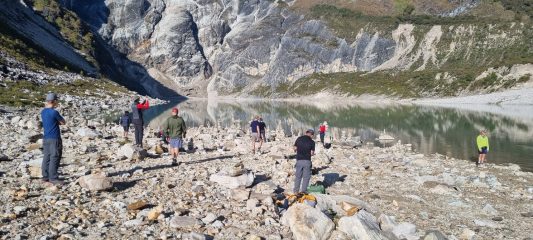
We set off early morning through a very slightly frosty open area where Yaks were grazing and as we approached the lake there it was in all its glory – Mount Manaslu at 8163m the 8th highest mountain in the world. Strange to think when we were at the lake the peak was 4000-5000m higher than us! The sheer scale of our surroundings was breathtaking. Although above us was a glacier and a million tonnes of ice, we were in T shirts and still enjoying the mid-morning sun which became our friend on these crisp mornings.
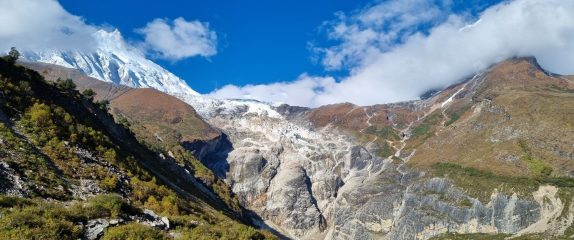
Trekking day 6 ended and for everyone it felt like a great day. We had visited a truly beautiful spot and spent a valuable day adjusting the higher altitude. The afternoon also allowed us to explore the local village and we soon found an excellent coffee shop which allowed a brief glimpse into the lives of the Nepalese people. We visited several of these simple coffee shops which all consisted of the same format. A small fire in the middle of the room and seats all around for warmth. The mattresses around the edge of the room highlighted that these families slept in here at night to benefit from the fire and the warm cooking area. I would image it was quite cosy and a real close- knit family area where everyone reflected on their day and planned the subsequent days tasks before the winter snows hit.
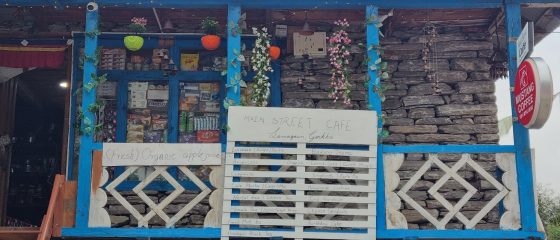
This was not Starbucks, these were enterprising Nepalese families who had opened their homes to cater for the increase in tourism. We spoke to several people who described what the Covid pandemic had done to their local economy – quite simple the tourists stopped, and their income ceased instantly. In the more developed Western World, many countries like the UK had Furlough schemes and financial aid packages that assisted millions of people to get through the Pandemic. The Nepalese people had nothing and had to live off the land and make do as best they could.
Trekking day 7 arrived with everyone feeling refreshed and we were already a week into our journey, the trees had disappeared, it was frosty now at night and the scenery more rugged surrounded by snowcapped peaks. We reached Samdo at 3870m by early afternoon and although winter was not here yet, we did not know at this point, it would arrive that evening. We had a nice meal around a warm fire in a dining room packed with trekkers getting ready to depart for their last stop before the Larkya Pass the next day.
One of my favourite pictures of the whole trip was this family separating the wheat from the chaff on the side of a hill. This really highlighted that they all have to pull together in a race against time before the biting winter blankets their village in a thick layer of snow. Tourist numbers will dwindle, and the mountain paths will become unmanageable in just a few short weeks.
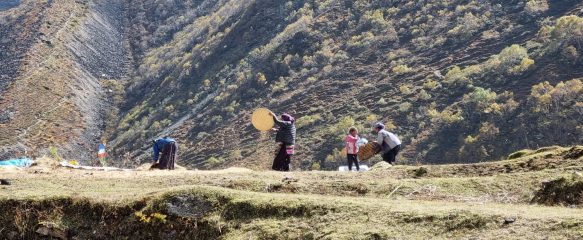
This is the epitome of a true team; the whole village comes together and does everything it can to ensure the success of the village. There are simply no individuals in this type of environment, it really was inspiring. In this photo you have a daughter, mother and grandmother all working together. The men tend to be more involved in construction.
This next picture was that afternoon, and the one after was the following morning, just 15 hrs later, what a contrast and it was to mark a difficult few days for the team.
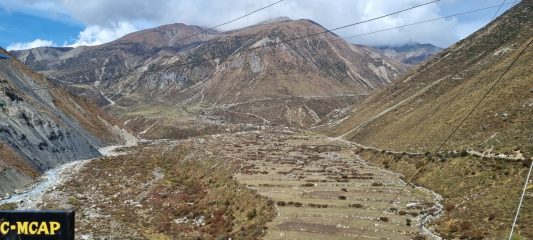
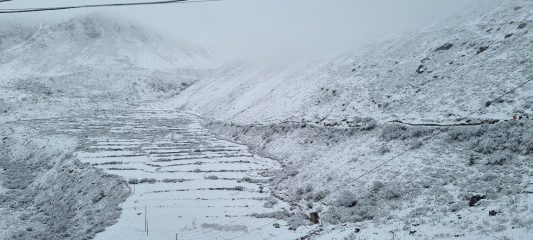
We woke early the next morning and were surprised to see a covering of snow had fallen throughout the night. We were quickly informed there would be no movement before 10am which would give the leadership team time to make an assessment of possible courses of action and formulate a contingency plan if we couldn’t leave. The snow continued to fall, and it was quickly decided that today was not the day to leave, and it would be best to have another acclimatisation day. This gave the group a unique opportunity to explore the village more fully and really immerse themselves into the Nepalese mountain culture. This was so far removed from Kathmandu just one week earlier, electricity was erratic, WIFI non-existent and most of the local houses were built from the stone of the mountains with simple sheet metal roofs. You use what you have when you live so remotely, it’s a simple formula.
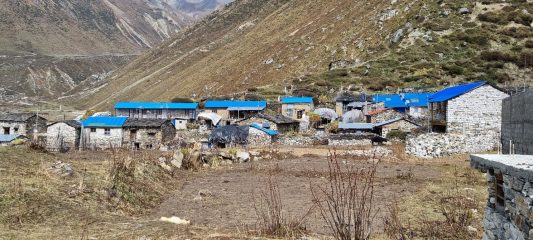
or
mous prayer wheel later that day and we were humbled by a local Nepalese woman saying prayers for our safety on the mountain. She seemed genuinely so warm and friendly, and we all felt the strength of the blessing she bestowed upon us. Feeling very humbled we then found a small café which was again someone’s home and another amazing insight to how the local people lived. The kitchen had literally everything in and eight of us sat down and were treated to a few stories of how the fabled snow leopards come down from the mountains in winter to prey on the livestock. Can you see the cat snuggled up under the stove, I was assured that this was not a snow leopard!
The next day and, if anything, the weather was slightly worse and yet again the decision was made for safety reasons that a delay of another 24 hrs was the most prudent course of action. A few more hot lemons with ginger, a quick lesson on 6 section battle drills followed by a game of monopoly and the day passed quickly. However the team was starting to get a little restless.
At last Trekking Day 10 and the weather was clear enough, so we were away on the short trek up Dharamsala, and we were up to a very oxygen reduced 4460m. The accommodation was sparse, and we were 4 to a room. Now it was cold, and I think everyone was really feeling it but sleeping so close together provided a welcome heat boost, but it was very claustrophobic.
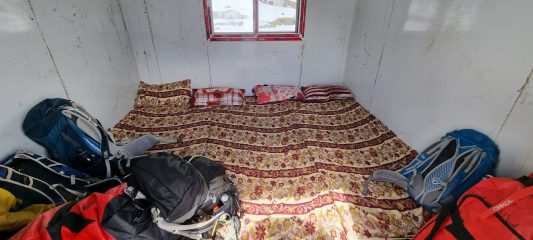
Breakfast was a very early 03:30 and we were away for 04:30. Many of us found sleeping very difficult that night, not just because of the excitement of the next day but the air was laden with significantly less oxygen, and you really did feel like you were gasping sometimes. But overall, the team was faring very well and with only a few minor headaches, confidence was high that we would all make it across Larkya Pass and join the 5000m plus club, something that very few people will ever experience. In hindsight the pause we had because of the snow really helped every acclimatise to the higher altitude.
What was more of a surprise was the biting cold, it literally penetrated everything and despite wearing many layers and several pairs of gloves a few of us found it very tough. That was until the sun finally came up over the peaks and we were treated to this view. It looked like the surface of the moon but coated in thick layers of snow and ice.
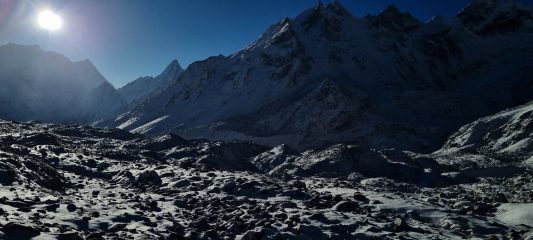
Pretty soon the temperature became much more tolerable, and everyone’s spirits lifted as we breached the 5000m barrier. Breaks were frequent now and fluid/snacks constant to keep us going. We could see the start of the pass a few hundred meters away which spurred everyone on and for a split second everyone relaxed a little until we heard the distant rumbling in the background from one of the peaks adjacent to us. AVALANCHE…………………
Around 2-3 km to the left-hand side of us, the warmth of the sun had made the previous night’s heavy snow deposit extremely unstable and now it had broken off. These walls of snow and ice can move at hundreds of kilometres per hour so a visible distance away soon became a reality that it might reach us.
Well, we are all here to tell the tale, so the most we endured was a slight spray of what could be described as ice crystal clouds passing over us, but it was firm reminder that this place holds many surprises and it not to be taken for granted, not even for a minute.
The excitement over and we finally reached the start of the pass, and the sign greeted us with our altitude 5106m. It was a welcome relief and a huge sense of pride that we had made it.
The weather had been extremely kind to us, in fact there was not a cloud in the sky and the previous frustrations of the last three days heavy snow were a distant memory. Our exped leader and mountain leaders as well as the Nepalese guides had successfully managed to get 14 people up safely and made some great decisions about when to trek and when to pause. The responsibility they held for the team must have weighed extremely heavily at times and I would image they were the most relieved out of all of us when we made it to the top.
We probably spent the best part of an hour on the top as it felt safe, warm and a privilege to be there but soon it was time to depart and descending can be treacherous, so we all wanted to get down safely before the light faded, even though we did not want the day to ever end.
A few short hours later we were down but the view continued to be absolutely breath taking. Its scale of the Himalayas that gets you, they just seem never ending.
The next tea house had a gas-powered red-hot shower which was amazing, and after a few days of no hot water, it was very welcome. But was that it? We had achieved the aim of the trip and crossed the Larkya pass but was there an element of deflation possibly within the team? No – not in the slightest.
What this had allowed us to do is focus on really enjoying and absorbing everything we could for the last few days now that the pressure was off after a very eventful few days, a blizzard and an avalanche. A couple more days descending off the mountain and the warm temperatures returned as well as the lush forests and this was the most colourful tea house yet we stayed at.
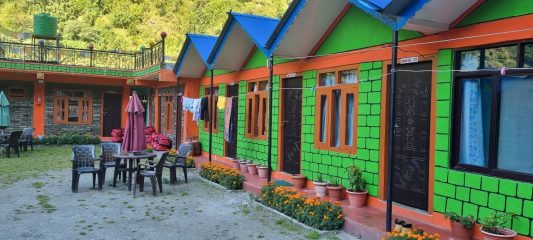
Some of the tea houses were incredibly pretty with really vibrant colours and looked like new. We soon found out that after a few floods and a some even more devasting landslides these villages were effectively brand new as they had been rebuilt over the last year or two.
It’s a tough life in an earthquake, monsoon plagued, landslide area of Nepal.
Finally, the trekking phase of our trip was over, and we took a long minibus ride to Pokhara, which as a large city was nothing like the tranquillity of last two weeks. Busy streets and haggling shop keepers were a new experience compared to the peace and quiet perspective of the mountains. However, it was good to see such vibrant life and it provided some comfort and relaxation time after such a long trekking experience.
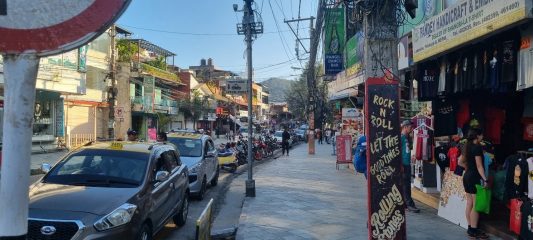
Two days in Pokhara and probably a few pounds lighter in terms of spending money as many gifts were purchased here by all and we set off back to Kathmandu and then onto the airport, ready for the long trip home.
On the morning we left I stood on the balcony of the guest house, and I could see Annapurna in the distance, Nepal’s 10th highest mountain, which felt so strange to be in such a hot bustling city with one of the most famous mountains seemingly just a stone’s throw away.
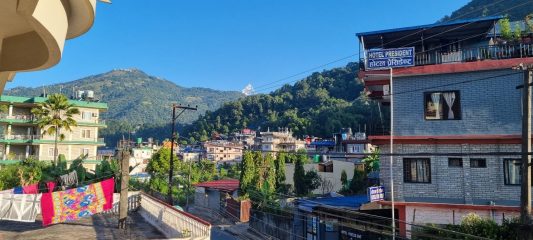
It dawned on me then that I was not finished with this once in a lifetime experience, this was not going to be a trip where I visited once, loved it and moved on to my next challenge.
There is just so much more to see in Nepal and having spoken to a few others in the team they felt the same. Others are already planning their next trip.
That’s what Nepal has done, it has given us a taste of something so beautiful, for many this would be start of start of our journey not the end.
So, it’s raining and cold and we are back in the UK now and we are all back to work, many in civilian jobs and some back in the Regiment but all carrying the memories of Nepal. We could not have done this without the extraordinary work of our Ex Ped-leader Captain Andrew Johnstone who put months of work into organising this or without his team of 3 mountain leaders to support him.
Overall, the Adventure training objectives were met, and this was by no small part also due to the financial support that Ulysses Trust provided. Everybody was well outside their comfort zone on many occasions, we have all achieved more than we ever dreamed of and not just because the expedition was so well planned but because so many things changed on the journey, and we had to adapt and overcome every change in circumstances and conditions. Our plan did not survive first contact with mother nature or the weather, but it did allow us to complete the most amazing trip.
Namaste !
